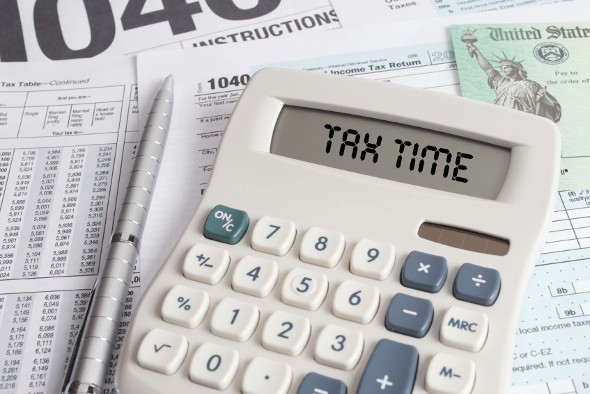The term “tax liability” describes the amount of money owed to the Internal Revenue Service (IRS) at the end of each tax year. Many Americans make reducing their tax liability a goal by chasing deductions and tweaking their filing strategy. If you want to know the answer to the question “Do I have tax liability?” you’ll have to compare your income to the deductions, exemptions and credits for which you’re eligible. A financial advisor can potentially help reduce your tax liability by creating a full financial plan for your goals.
Tax Liability Definition
The definition of tax liability is the amount of money or debt that an individual or entity owes in taxes to the government. In general, when people refer to this term they’re referring to federal income tax liability. If your income is low enough you won’t have any tax liability at all. Your standard deduction will exceed your taxable income, leaving you with nothing owed to the IRS. Millions of Americans are in this situation. They don’t pay federal income taxes and many don’t file taxes.
That doesn’t mean, however, that they don’t pay taxes at all. Most of those who don’t pay federal income taxes pay payroll taxes through work. There are also state and local taxes, sales taxes and other taxes that capture revenue even from folks with very low incomes.
How to Reduce Your Tax Liability
If you’re not among the group with no income tax liability and you want to reduce your tax bill, what can you do? There are a few strategies.
1. Claim the Right Deductions
First off, it’s a good idea to make sure that you’re claiming all the deductions you’re eligible to claim. This is where tax preparation software (like TurboTax or H&R Block) or the service of an accountant can really come in handy, but it is possible to do it yourself.
2. Adjust Your Tax Withholding
If you want to reduce your tax liability you can also adjust your payroll tax exemptions by filing a new W-4 with your employer. There are different schools of thought around this tax strategy, though. If you have too little withheld you’ll owe more at tax time. Nobody likes that feeling. The IRS has a tax withholding estimator that can help ensure you don’t have too much or too little income tax withheld.
3. Contribute to a Retirement Account
One of our favorite ways to reduce tax liability and prepare for your future is to save for retirement. Contributions to 401(k)s reduce your taxable income, as do contributions to deductible traditional IRAs. In 2026, the IRS allows you to make up to $24,500 in pre-tax contributions to 401(k)s and similar workplace accounts (plus $8,000 if you are 50 or older). The contribution limit for IRAs is $7,500 in 2026 (plus $1,100 if you are 50 or older). Contributions to Roth IRAs, however, are made with after-tax dollars and do not reduce your tax liability in the year you contribute.
4. Donate to Charity
Another popular method for reducing your tax liability is to donate to charity. Donations to qualified charities are tax-deductible. A tax deduction reduces your taxable income, which in turn reduces your tax liability. Giving away money or other assets is a great way to both lower your tax bill and support the causes close to your heart.
It’s important to obtain proper documentation for all of your donations. And of course, you can only deduct donations if you decide to itemize your deductions rather than taking the Standard Deduction. For many people, the Standard Deduction gives them a bigger tax break than they would get if they itemized, but your mileage may vary.
Deferred Tax Liability

Own a business? You may need to understand how deferred tax liability works. It stems from a “book-tax difference,” which is largely a difference of timing between financial accounting rules and IRS rules.
Take the five-year depreciation of a business asset as an example of deferred tax liability. Accounting rules and IRS rules are different when it comes to depreciation. The difference between the tax expense (from financial accounting) and the tax payable (from IRS accounting) tells you whether you have a deferred tax liability or a deferred tax asset.
If in the future you will pay more to the IRS than the tax expense noted in your books, you have a deferred tax liability. This also happens if a business reports less taxable income than the income on its financial statements.
Your business has a deferred tax asset if less tax will be paid in the future than is due now. In other words, a deferred tax asset is the opposite of deferred tax liability. If a company reports more taxable revenue than book revenue in the current period, it will “prepay” its taxes. That means less taxable income and taxes to pay in the future.
For example, the calculation for bad debt is different for financial accounting and tax purposes. This leads to higher taxes payable in the year of the debt and lower taxes in the future. That’s a deferred tax asset.
Tax Liability for Capital Gains
If you sell any asset, including real estate or other investments, for a gain then you may owe taxes on that profit. For example, if you buy a house for $500,000 and sell it 10 years later for $1 million, your capital gains tax liability will be based on the $500,000 in profits the sale generated.
When an asset is held for more than a year, the transaction becomes a long-term capital gain. Long-term capital gains are taxed at a lower rate than short-term capital gains would be.
2026 Short-Term Capital Gains Tax Rates
| Rate | Single | Married, Filing Jointly | Married, Filing Separately | Head of Household |
|---|---|---|---|---|
| 10% | $0 – $12,400 | $0 – $24,800 | $0 – $12,400 | $0 – $17,700 |
| 12% | $12,400 – $50,400 | $24,800 – $100,800 | $12,400 – $50,400 | $17,700 – $67,450 |
| 22% | $50,400 – $105,700 | $100,800 – $211,400 | $50,400 – $105,700 | $67,450 – $105,700 |
| 24% | $105,700 – $201,775 | $211,400 – $403,550 | $105,700 – $201,775 | $105,700 – $201,750 |
| 32% | $201,775 – $256,225 | $403,550 – $512,450 | $201,775 – $256,225 | $201,750 – $256,200 |
| 35% | $256,225 – $640,600 | $512,450 – $768,700 | $256,225 – $384,350 | $256,200 – $640,600 |
| 37% | $609,351+ | $768,700+ | $384,350+ | $640,600+ |
2026 Long-Term Capital Gains Tax Rates
| Tax Rate | Individuals | Married Filing Jointly | Head of Household | Married Filing Separately |
|---|---|---|---|---|
| 0% | $0 – $49,450 | $0 – $98,900 | $0 – $66,200 | $0 – $49,450 |
| 15% | $49,450 – $545,500 | $98,900 – $613,700 | $66,200 – $579,600 | $49,450 – $306,850 |
| 20% | $545,500+ | $613,700+ | $579,600+ | $306,850+ |
However, both short-term and long-term capital losses are treated the same way when it comes to tax liability. Losses can be applied against gains that were incurred during the same tax period. They can also be carried forward, in some cases, to future years.
How a Financial Advisor Can Help Manage Your Tax Liability
A financial advisor can play a key role in helping you manage and reduce your tax liability through a range of coordinated strategies. One common approach involves reviewing your income sources and identifying opportunities to reduce taxable income through pre-tax retirement contributions, health savings accounts (HSAs) and flexible spending accounts (FSAs). Advisors also help evaluate whether itemizing deductions like charitable donations or mortgage interest would provide a greater tax benefit than taking the standard deduction.
For individuals with investments, an advisor can assist in planning the timing of capital gains and losses to minimize taxes owed. This includes strategies like tax-loss harvesting, deferring gains to future tax years, or structuring withdrawals from taxable and tax-advantaged accounts in a way that reduces your marginal tax rate. For those nearing retirement, advisors may use Roth conversions or qualified charitable distributions (QCDs) to help manage required minimum distributions (RMDs) and control future tax exposure.
Business owners can benefit from guidance on entity structure, expense planning and how to account for deferred tax liabilities. A financial advisor may work with your tax professional to ensure accurate reporting of income and deductions, while also reviewing year-end strategies that align with your broader business and personal financial goals.
In all cases, the advisor’s role is to develop a tax-aware financial plan that balances current tax efficiency with long-term growth, estate planning considerations and income sustainability. While they do not replace a CPA, financial advisors can add value by integrating tax considerations into a comprehensive planning framework.
Bottom Line

Whether you’re a business owner or an individual, figuring out your tax liability ahead of time will help you avoid surprises this tax season. However, the unpredictable nature of taxes is one reason it’s important to keep an emergency fund. That way, if your tax liability varies from year to year, you’ll have enough to cover the difference.
Tips for Understanding Your Taxes
- A financial advisor can help you optimize your taxes for your investing and retirement goals. Finding a financial advisor doesn’t have to be hard. SmartAsset’s free tool matches you with vetted financial advisors who serve your area, and you can have a free introductory call with your advisor matches to decide which one you feel is right for you. If you’re ready to find an advisor who can help you achieve your financial goals, get started now.
- Worried about filing yoru taxes? SmartAsset has you covered with a number of free online tax resources to help you manage your taxes. Go online to our website and check out our income tax calculator today.
- If you don’t know whether you’re better off with the standard deduction versus itemized, you might want to read up on it and do some math. You might find that you’d save a significant amount of money one way or another, so it’s best to educate yourself before the tax return deadline.
Photo credit: © iStock/aydinynr, © iStock/TCassidy, © iStock/Biletskiy_Evgeniy
